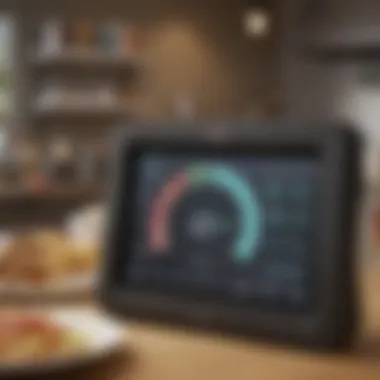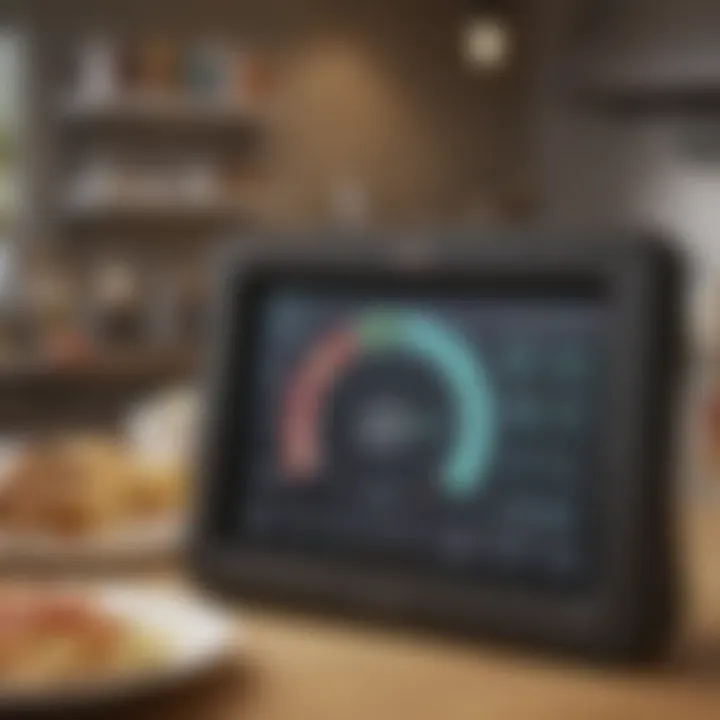Understanding Restaurant Delivery: An In-Depth Exploration


Intro
The landscape of dining has undergone significant changes over the past few years. Restaurant delivery services have emerged as a key player in how consumers engage with food establishments. This shift has not only altered customer expectations but also transformed operational dynamics within restaurants. In this exploration, we will dissect the essential components of restaurant delivery, focusing on the systems in place, the technology driving them, and the behavioral trends that are reshaping market strategies.
As we analyze this topic, several key points will emerge. We will discuss the role of delivery platforms like DoorDash and Uber Eats, examining their influence on restaurant operations and customer behavior. Furthermore, we will identify the challenges that restaurants encounter in adapting to this delivery-centric model.
Additionally, we'll explore how consumer preferences and technological advancements are intertwined, driving the evolution of culinary experiences. The ultimate goal is to present a thorough understanding of how restaurant delivery services are not just a convenience but a fundamental part of modern dining.
The Evolution of Restaurant Delivery Services
The evolution of restaurant delivery services carries significant importance in understanding how modern dining experiences have reshaped consumer habits. These services are not merely an add-on feature; they have become an integral part of the restaurant industry. As market demands increase and technology becomes more accessible, understanding this evolution helps to reveal the shifts in operational strategies, consumer preferences, and market competition.
Various factors play into the growth and evolution of restaurant delivery. These include customer convenience, technological advancements, and changing societal dynamics. As urban populations increase, consumers seek simpler solutions to fulfill their dining needs. Moreover, the digital transformation has prompted restaurants to adapt to a competitive landscape, offering delivery as a core service.
Historical Context
Historically, restaurant delivery services have undergone several transformations. In the early days, food delivery was often limited to local fried chicken shops and pizza outlets. This rudimentary service was typically done via phone orders, with little emphasis on marketing or logistics. As consumer lifestyles evolved, so did the expectations of food delivery service.
In the 1970s and 1980s, the rise of technology began to impact restaurant delivery. Ordering systems introduced basic concepts of menu design and order tracking. However, it was the innovation of the internet in the 1990s that dramatically changed the landscape. Online ordering systems became practical with faster communication methods, leading to a boom in delivery services offered by restaurants.
Modern Developments
Today, modern delivery services encompass a range of offerings that span far beyond traditional pizza joints. Companies like Uber Eats, DoorDash, and Grubhub have changed the game with their user-friendly platforms that allow customers to browse multiple restaurants in one go. These platforms provide essential data analytics to restaurant owners, assisting them in understanding consumer patterns and preferences.
The integration of mobile applications has made the ordering process seamless. Customers can now place orders directly from their smartphones, which enhances convenience and accessibility. Furthermore, GPS-enabled tracking allows customers to monitor their orders in real time, providing insight into delivery times and enhancing the overall user experience.
"The shift from traditional delivery methods to modern technology-enabled services marks a pivotal point in restaurant service evolution, reflecting consumer desires for convenience and efficiency."
Additionally, the recent pandemic has accelerated the transformation of delivery services. Many restaurants had to pivot to delivery and takeout models to surVice during lockdowns. This shift forced the industry to innovate quickly, leading to creative solutions like contactless delivery and enhanced safety protocols.
Through these historical and modern developments, it is evident that the restaurant delivery service is not static. Rather, it adapts to the needs of both consumers and businesses in a continuously changing digital landscape.
Technological Transformation in Delivery
The rise of technology has played a crucial role in the evolution of restaurant delivery services. It has reshaped how customers interact with these services and how restaurants manage logistics and operations. Embracing technological transformation is essential for staying relevant in an increasingly competitive market. Convenience, speed, and efficiency are the main benefits that technology brings to delivery. It allows restaurants to minimize costs, optimize workflows, and enhance customer experiences.
Mobile Apps and Their Impact
Mobile applications have become central to how consumers order food. The emergence of apps like Uber Eats, DoorDash, and Grubhub has simplified the ordering process. Users can browse nearby restaurants, read reviews, and see menus without leaving their home. This ease of access increases the likelihood of impulse orders, benefiting restaurants significantly. Moreover, apps facilitate payment processing, allowing for a swift, cashless transaction. Integration with loyalty programs is another advantage, motivating repeat business through rewards and discounts.
GPS and Real-Time Tracking
Global Positioning System (GPS) technology has revolutionized restaurant delivery. Customers benefit from being able to track their order in real-time. This transparency enhances the customer experience by keeping them informed about delivery status and estimated arrival times. For restaurants, GPS aids in optimizing delivery routes. This reduces wait times and enhances the efficiency of delivery personnel. Implementing real-time tracking can improve customer satisfaction and trust, which is vital in building loyal clientele.
Automation and Robotics
The introduction of automation and robotics in delivery is still in its early stages, but its potential is vast. Autonomous delivery robots are appearing in some urban areas, while drones are also being tested for food deliveries. These technologies promise to reduce labor costs and improve delivery speed. However, challenges remain regarding regulation and public acceptance. Brands must carefully consider the practicalities of integrating such technologies into their operations.
Technological transformation in delivery is not just about adopting new tools. It is about fundamentally changing how food is delivered, enhancing service, and meeting customer needs in a dynamic market.
In summary, the technological landscape is continuously evolving, and restaurant delivery services must adapt to remain competitive. From mobile apps facilitating ease of ordering to GPS systems enhancing efficiency, the aspects outlined above are crucial in shaping the future of food delivery.
Market Dynamics of Restaurant Delivery
The market dynamics of restaurant delivery are complex and continually evolving. As consumer preferences shift towards convenience, the importance of understanding these dynamics becomes crucial. It helps stakeholders in the industry develop effective strategies to engage consumers, optimize operations, and maintain a competitive edge. The intersection of technology, customer expectations, and pricing models significantly affects how restaurants reach their customers and how they monetize delivery services.
Key Players in the Industry
In the restaurant delivery market, several key players shape its landscape. These include delivery platforms such as Uber Eats, DoorDash, Grubhub, and Postmates. Each platform has unique offerings and varying degrees of market reach. They facilitate the connection between consumers and restaurants, impacting how dining establishments operate. Moreover, local and regional delivery services are also emerging, catering to specific tastes and preferences.
Restaurants themselves are integral players, adapting their menus and operations to cater to delivery demands. Some opt to partner with delivery platforms, while others might choose to maintain in-house delivery teams for better control over the experience. The balance of power among these players can shift based on market trends and consumer behaviors.
Competitive Strategies


The competition in restaurant delivery is fierce. Players employ several strategies to capture market share and enhance customer satisfaction. One common approach is maximizing convenience through user-friendly mobile applications. Providing an intuitive interface can improve order accuracy and increase customer retention.
Moreover, restaurants can focus on specialization. Establishments may offer curated menus specifically for delivery, ensuring the food remains at ideal quality during transit. Additionally, offering unique promotions or discounts can attract new customers and retain existing ones. Relationships with local businesses, like breweries or artisan bakeries, can also provide an edge, allowing restaurants to create exclusive partnerships that enhance the overall offering.
Pricing Models and Profit Margins
Understanding the intricacies of pricing models is vital in the restaurant delivery market. Various pricing structures exist, such as flat fees, percentages of order totals, and subscriptions. Meal subscription services, for instance, allow customers to pay a monthly fee for regular deliveries, providing predictable revenue for restaurants.
Profit margins in restaurant delivery can be slim. Restaurants must navigate the costs associated with commission fees from delivery platforms, packaging, and logistics. By carefully analyzing pricing strategies and adjusting their approach, restaurants can maintain profitability while still offering competitive prices to their customers.
The dynamics of the restaurant delivery market are constantly changing, highlighting the need for continuous adaptation and innovation.
As the sector progresses, understanding these market dynamics will be essential for anyone involved in the restaurant delivery industry. It allows stakeholders to identify opportunities and challenges, ensuring they can respond to shifts in consumer behavior and market trends effectively.
Consumer Behavior and Expectations
Understanding consumer behavior and expectations is crucial in the context of restaurant delivery services. This topic illustrates how modern dining is not just about food, but about convenience, speed, and experience. As food lovers increasingly turn to delivery options, their preferences reveal significant insights for restaurants aiming to thrive in this competitive market.
Changing Preferences
Recent years have witnessed a notable shift in consumer preferences. Many diners now prioritize convenience, opting for delivery over traditional dine-in experiences. A variety of factors contribute to this trend. Busy lifestyles dictate that consumers seek quick and easy access to meals, often preferring apps and websites for their orders. Moreover, the diverse range of cuisines available at the touch of a button encourages exploration beyond local favorites.
Trends such as health consciousness and dietary restrictions are also influencing choices. Many consumers now favor restaurants that offer customizable options, like vegan or gluten-free meals. This expectation pushes establishments to adapt their menus to cater to evolving tastes and dietary needs. As competition intensifies, satisfying changing preferences can significantly impact customer loyalty and retention.
Demographics of Delivery Users
The demographics of delivery users shed light on who utilizes these services. Young adults, particularly millennials and Gen Z, represent a large segment of the delivery market. These groups value experience, often seeing food delivery as part of their social activities. They leverage social media to share their dining experiences, influencing others' perceptions and choices.
However, it's not solely younger generations who benefit from delivery services. Busy professionals and families also turn to delivery for ease, showcasing a broader market. Identifying the demographic trends allows restaurants to tailor marketing efforts and menu offerings. For instance, family bundles could attract parents looking for convenient meal solutions.
Feedback and Reviews
Feedback and reviews play a pivotal role in shaping consumer expectations. Many users rely heavily on ratings and comments from others before making decisions. Positive reviews can enhance a restaurant's reputation, while negative feedback can deter potential customers. As such, restaurants must actively engage with these reviews. Responding to both praise and criticism shows potential diners that a restaurant values customer opinion and is committed to continuous improvement.
Online platforms like Yelp and Google Reviews serve as essential tools. They not only provide insight into customer experience but also help in refining delivery processes. Through understanding feedback patterns, restaurants can address issues regarding timing, food quality, or packaging. This adjustment not only meets expectations but can exceed them, turning first-time users into repeat customers.
"Listening to your customers is the key to improving their delivery experience."
Challenges Facing Restaurant Delivery
The growth of restaurant delivery services has been remarkable in recent years. However, challenges remain significant. Addressing these issues not only enhances operations but also improves customer satisfaction. Recognizing the importance of this area ensures that restaurants stay competitive and can adapt to changing market dynamics.
Quality and Consistency Control
Maintaining quality and consistency is crucial in the restaurant delivery sector. Customers expect their food to arrive as if they just ordered it on-site. This can be complicated, given that meals may sit for extended periods during transit. Temperature control, packaging, and handling practices influence food quality. Restaurants must invest in proper packaging to keep food fresh and appealing.
Moreover, establishing standardized processes for food preparation can help maintain consistency. If the same dish tastes different from one delivery to another, customers may become dissatisfied. This discontent can result in negative reviews or a loss of repeat business. Thus, implementing quality checkpoints throughout the preparation and delivery process is vital to sustaining a reputable service.
Logistics and Supply Chain Issues
Logistics represents another significant challenge for restaurant delivery services. Delivery operations are complex, contingent upon factors such as distance, traffic conditions, and the efficiency of delivery personnel. Restaurants often face hurdles in route optimization. If delivery times become excessive, this not only frustrates customers but can also lead to cold or soggy food, violating the expectations of diners.
Supply chain management is equally important. A breakdown in the chain can lead to delays in delivery or poor ingredient quality, affecting the final product. To mitigate these risks, restaurants should develop strong relationships with suppliers and delivery partners. Investing in real-time tracking systems also helps in managing logistics effectively. A transparent tracking system allows both the restaurant and the customer to monitor the delivery process, fostering trust.
Sustainability Concerns
Sustainability is increasingly taking center stage in the food delivery debate. Customers are becoming more aware of their choices' environmental impact. As a result, restaurant delivery services must confront issues such as excessive packaging waste and carbon footprints associated with point-to-point deliveries.
Restaurants can address these concerns by opting for eco-friendly packaging materials and implementing sustainable practices. Using recyclable or biodegradable containers, for instance, not only helps the environment but can also enhance brand reputation among eco-conscious consumers. Additionally, bundling orders within a certain area can minimize the carbon footprint of deliveries. Engaging in these practices demonstrates a commitment to sustainability, which can resonate with a growing segment of environmentally-aware customers.
"A sustainable delivery model not only protects the planet but also meets the evolving expectations of modern consumers."
In summary, while restaurant delivery faces a myriad of challenges, understanding and addressing these can lead to more successful and customer-friendly operations. Quality control, logistics, and sustainability must all work in harmony to create a dining experience that meets the demands of today’s consumers.


Innovative Trends in Delivery Services
The landscape of restaurant delivery services is constantly evolving, influenced by the need for efficiency and adaptability in a competitive market. Recognizing innovative trends is essential, as they dictate not only operational methods but also consumer experiences. As more restaurants integrate these trends, understanding their significance becomes paramount.
Subscription-Based Models
Subscription-based models are reshaping how consumers engage with food delivery. This approach allows customers to pay a fixed monthly fee for regular delivery options or discounted rates. The benefits are numerous:
- Cost Savings: For frequent users, subscriptions can lead to substantial savings compared to traditional pay-per-order systems.
- Predictable Revenue: Restaurants enjoy more predictable revenue streams, making it easier to manage inventory and staffing needs.
- Loyalty Building: Customers feel more invested, fostering a sense of loyalty that can translate into repeat business.
For instance, companies like DoorDash offer subscription services that provide users lower fees and exclusive access to certain restaurants. These models have gained traction, particularly during the pandemic, when consumers sought convenient meal options.
Ghost Kitchens and Their Rise
Ghost kitchens, also known as virtual kitchens, have emerged as a significant trend within the delivery services sphere. These establishments focus solely on preparing food for delivery and lack a traditional dine-in space.
- Reduced Overhead Costs: Without the need for a customer-facing location, these kitchens lower initial capital expenditure significantly. This makes it appealing for new businesses.
- Diverse Menus: Ghost kitchens can experiment with various brands under one roof, offering a wide variety of cuisines to meet diverse consumer demands. This flexibility can help them quickly adapt to changing market conditions.
- Location Optimization: By strategically selecting locations based on delivery zones, ghost kitchens can optimize their reach.
As a result, ghost kitchens have altered the competitive landscape. They allow existing restaurants to expand their reach without the burdens of a full-scale operation.
Partnerships with Local Businesses
Another innovative trend is the collaboration between restaurants and local businesses. These partnerships can take many forms: restaurants may join forces with local farms for fresh produce or partner with delivery services that specialize in neighborhood reach.
- Support for Local Economies: Such partnerships not only foster community support but also enhance brand image as local and sustainable.
- Unique Offerings: Restaurants can create exclusive menus featuring local ingredients, appealing to environmentally conscious consumers.
- Shared Resources: Collaborating with local businesses often means sharing logistical resources, which can alleviate some of the operational strains that come with running a restaurant.
Effective partnerships create a win-win situation. They strengthen local economies while providing restaurants with unique selling propositions that can attract a dedicated customer base.
"The collaboration between food businesses and local farms can create a sustainable cycle that benefits everyone involved, from the producers to the consumers."
Engaging with these innovative delivery trends enables restaurants to adapt to the shifting landscape, appealing to modern consumer preferences for convenience and sustainability.
The Future Landscape of Restaurant Delivery
The future of restaurant delivery is a pivotal topic within the overall analysis of delivery services in the culinary industry. As consumer habits evolve and technology continues to advance, understanding these changes is essential for both restaurant operators and customers. Acknowledging the upcoming trends can help businesses position themselves strategically. Moreover, customers benefit from being informed about what to expect in their dining experiences. This section will explore predicted trends and developments while also highlighting the impact of artificial intelligence and data analytics on the future delivery landscape.
Predicted Trends and Developments
Various trends are likely to shape the landscape of restaurant delivery in the coming years. One anticipated trend is the increase in efficiency through enhanced logistics systems. Restaurants are expected to leverage sophisticated algorithms to streamline their delivery routes, reducing wait times for customers. This shift will likely improve customer satisfaction and loyalty.
Another development is the rise of diverse food options. More restaurants may expand their delivery menus to cater to a wider range of dietary preferences, from vegan choices to gourmet selections. As health consciousness rises among consumers, the demand for healthier meal options will likely lead to innovative menu designs.
Additionally, the concept of ghost kitchens will continue to gain traction. These kitchens operate without a physical dining space and focus solely on delivery. They allow for reduced overhead costs and the ability to experiment with new culinary concepts without significant risk.
Moreover, subscription services for delivery are expected to grow. Customers may prefer the convenience of a subscription model that offers regular deliveries at a set price. Such models not only provide predictability for consumers but also secure regular revenue for restaurants.
Impact of AI and Data Analytics
Artificial intelligence is poised to be a game-changer for restaurant delivery services. One of the primary applications of AI will be in predicting consumer preferences. By analyzing past order data, algorithms can suggest menu items that align with customer tastes, thus enhancing the user experience.
Data analytics will also play a critical role in optimizing inventory management. By understanding demand patterns, restaurants can minimize food waste and ensure that popular items are always available.
Furthermore, AI can enhance customer service through chatbots. These chatbots can provide immediate responses to customer inquiries and streamline the ordering process. This integration can lead to a more seamless and satisfying customer experience.
In summary, the future of restaurant delivery is characterized by advancements in technology and shifting consumer expectations. As businesses adapt to these changes, understanding the evolving landscape will be crucial for success in the competitive dining market.
Regulatory Considerations
In the ever-evolving realm of restaurant delivery services, regulatory considerations play an integral role. These regulations shape how businesses operate, impacting both restaurants and consumers alike. They ensure a balance between fostering growth in the industry and maintaining standards for safety, fairness, and quality. Understanding these regulatory frameworks can help stakeholders navigate their responsibilities and expectations effectively. This section offers an overview of key regulations that affect restaurant delivery services, focusing on health and safety, as well as labor laws.
Health and Safety Regulations
Health and safety regulations are critical in the food service industry. They protect consumers from foodborne illnesses and ensure that restaurants uphold hygiene standards. For delivery services, these guidelines encompass various aspects of food handling, packaging, and transport.


Key elements include:
- Food Safety Protocols: Restaurants must adhere to strict guidelines on food preparation and storage. Proper cooking temperatures and sanitation practices are vital to prevent contamination.
- Package Integrity: Packaging must be designed to keep food safe during transit. This means using materials that maintain temperature and prevent leakage.
- Driver Health Policies: Delivery personnel must follow health regulations, including measures related to illness and personal hygiene.
Adhering to health and safety regulations not only protects consumers but also enhances a restaurant's reputation. Non-compliance can lead to penalties and a loss of business.
"A commitment to health standards can significantly impact customer trust and loyalty."
Labor Laws and Rights
Labor laws are another important area of regulatory consideration. These laws govern the working conditions, rights, and benefits of delivery staff. As the demand for delivery services grows, it is essential to ensure that workers are treated fairly and compensated adequately.
Key aspects include:
- Minimum Wage: Delivery drivers are entitled to at least the minimum wage. However, many drivers rely on tips, which can complicate wage structures. Understanding local laws on tip credits is important for compliance.
- Workplace Safety: Regulations require that delivery personnel be provided with a safe working environment. This includes proper training, equipment, and support against workplace hazards.
- Hours and Benefits: Regulations govern maximum working hours, overtime pay, and access to benefits such as health insurance. Ensuring that drivers receive fair treatment is crucial for retention and morale.
Failure to comply with labor laws can result in lawsuits and regulatory penalties. Furthermore, it reflects poorly on a company's values and commitment to its workforce. By prioritizing fair labor practices, restaurants can create a more sustainable delivery model.
Marketing Delivery Services Effectively
Marketing delivery services is essential in the current restaurant landscape. The competition is intense. With numerous options available, restaurants must distinguish themselves. Effective marketing not only increases visibility but also attracts and retains a loyal customer base. Each strategy used must align with the broader business goals. This applies to branding, customer engagement, and sales objectives.
Digital Marketing Strategies
The world has seen a shift towards digital marketing. Restaurants must adjust their marketing tactics accordingly. Here are some key strategies that can be useful:
- Search Engine Optimization (SEO): Optimizing an online presence ensures that a restaurant appears in searches related to food delivery. Keywords such as "best delivery services" or "local restaurant delivery" can guide potential customers.
- Content Marketing: Creating valuable content can engage users. Blogs or videos about menu items, preparation methods, and special events can attract viewers. They often share this content, which increases reach.
- Email Marketing: Sending newsletters or promotional offers to previous customers helps keep the restaurant top-of-mind. It is an effective way to inform about new menu items, discounts, or exclusive delivery options.
- Pay-Per-Click Advertising: Targeted ads on platforms like Google or social media can drive traffic. Restaurants can focus on specific demographics and geographic areas, reaching customers more effectively.
Social Media Influence
Social media presence has significant impact on marketing delivery services. Platforms like Facebook and Instagram showcase food visually. Engaging potential customers requires interaction and consistency. Here are some effective practices:
- Engagement: Responding to comments and messages shows a restaurant cares about customer feedback. This builds a positive reputation.
- User-Generated Content: Encouraging users to share their own photos of meals can be effective. This type of content acts as authentic marketing, often more persuasive than formal advertisements.
- Influencer Collaborations: Partnering with local influencers can elevate visibility. Influencers have established trust with their audience, which can translate into new customers for the restaurant.
"Successful marketing is not just selling but creating connections with customers."
- Promotions and Giveaways: Running contests or special promotions can attract attention. It encourages sharing, further expanding reach across social networks.
In summary, implementing effective digital marketing strategies and leveraging social media influence are crucial elements for promoting restaurant delivery services. With an innovative approach, restaurants can create a robust marketing framework that resonates with today's food-loving consumers.
Finale: The Impact of Delivery on Dining
The significance of restaurant delivery services in the modern culinary landscape cannot be overstated. This article has explored various dimensions of delivery, unveiling how it meets consumers' evolving expectations while reshaping the dining experience. Understanding these impacts is crucial for stakeholders in the food industry, from restaurateurs to diners.
Restaurant delivery services provide significant benefits to both consumers and businesses. For diners, the convenience and flexibility offered by these services streamline their meal choices. Being able to order from a diverse range of restaurants without leaving home caters to modern lifestyles that prioritize efficiency and comfort. Additionally, delivery allows restaurants to reach a broader audience, increasing their market share and potential revenue.
However, the rise of delivery also comes with considerations. Quality control and consistency are paramount. The experience of receiving a meal can sometimes fall short if operational standards are not maintained during the delivery process. Hence, restaurants must implement robust measures to ensure that the food remains fresh and appealing.
"As restaurant delivery evolves, it becomes essential to maintain high standards to boost consumer trust and loyalty."
Moreover, the integration of technology is transforming how delivery services operate. Mobile applications facilitate seamless ordering while enabling real-time tracking, significantly enhancing the customer experience. Innovative solutions such as automation and the use of AI are paving the way for more efficient logistics.
In summary, the impact of delivery on dining is vast and continues to grow. As dining preferences shift towards convenience, restaurants must adapt to these changes to thrive in a competitive market. Effectively leveraging delivery services can help businesses not only survive but also flourish in an ever-evolving food landscape.
Summarizing Key Insights
The exploration of restaurant delivery reveals several key insights:
- Consumer Preferences: There is a discernible shift towards online ordering and home delivery, reflecting societal changes in lifestyle and dining habits.
- Technological Integration: Advancements in technology play a pivotal role in enhancing delivery efficiency and customer satisfaction.
- Market Dynamics: Understanding competitive strategies and pricing models is essential for restaurant success in a saturated market.
- Quality Assurance: Maintaining food quality during transport is critical to ensure customer retention and satisfaction.
Each of these elements underscores the importance of adapting to the growing trend of delivery services while keeping customer needs at the forefront.
Looking Ahead
Looking to the future, restaurant delivery services are expected to continue evolving. Here are some anticipated trends:
- Increased Use of AI: As data analytics becomes more sophisticated, AI will likely play a more significant role in predicting consumer behavior and optimizing delivery routes.
- Sustainability Initiatives: The focus on sustainable practices will increase, with restaurants striving to minimize their carbon footprint while catering to environmentally-conscious consumers.
- Expansion of Delivery Options: Subscription models may gain traction, allowing consumers to benefit from regular deliveries at discounts or exclusive offerings.
Adapting to these trends will be crucial for restaurants aiming to stay relevant in an increasingly dynamic market. By preparing for the future of delivery, restaurants can ensure they remain integral to the dining experience.







